This website is supported by its readers. If you click one of my links I may earn a commission. I am also a participant in the Amazon affiliates program and I will also earn a commission from qualified purchases.

With the rise in organic produce, more and more people are looking to grow their own fruit. With bonsai trees also increasing in popularity, naturally, a lot of people are asking if it is possible to grow fruit through their bonsai trees. So what are the best bonsai fruit trees for beginners?
Apple, crabapple, olive, lemon, and fig (ficus), are the best bonsai fruit trees for beginners. These bonsai can be grown in most climates. Other bonsai fruit trees for beginners include orange, cherry, pomegranate, winterberry, and blueberry varieties.
So which of these are the best bonsai fruit trees for beginners? And what are the advantages/disadvantages of the supposed best bonsai trees for beginners? Keep reading to find out more.
Just a quick heads up, over the past three years of running Plantpaladin, hundreds of people have asked for product recommendations. As such, You can find my favorite indoor bonsai tree here (link takes you to Bonsaiboy), my favorite outdoor bonsai tree (link takes you to Bonsaiboy), or have a look at all the products I recommend here.
Apple bonsai
Apple trees can make for ideal bonsai trees.
What’s even better is that despite bonsai trees being relatively small in size, they can still produce regular-sized fruit depending on the species.
Requirement | Detail |
Water | Once per day in summer, twice per week in winter. Touch to see if the topsoil is dry before watering. Do not water when topsoil is wet. |
Sunlight | 6 to 8 hours of direct sunlight in the summer months. |
Soil Mix | Akadama and volcanic rock mix |
Fertilizer | Once per month in the spring and summer. No fertilizing in the fall and winter |
Location | Outdoor only, bright spots in the garden. |
Time to grow into mature bonsai | 10 years |
Advantages of apple tree bonsai
The main advantages of apple tree bonsai as a beginner are:
- They are widely available – Meaning that the initial cost to grow one of these will be very low when compared to other fruiting bonsai
- Can take a lot of damage – Unlike other fruits where cutting branches or changes in temperature will cause significant damage to the bonsai, apple trees are very resilient meaning that these changes won’t impact them that much
- Grow in most climates – Regardless of where you are in the world, apple tree bonsai will be able to grow there.
Disadvantages of apple tree bonsai
The main disadvantages of apple tree bonsai as a beginner are:
- They attract pests – during the fall when apples are ready to harvest expect a lot of insect infestation as bugs start to feed on your fruit
- The seeds can be toxic – The seeds from the apple can be very toxic to dogs.
- They can take a while to bear fruit – Apple trees can take up to ten years until they have been matured into a bonsai and an additional 6 years until they start bearing fruit.
When to pick the apples?
Apples from apple bonsai will most commonly need to be picked in the fall, between September, October, and November. Appletree bonsai then needs to be planted or repotted as early in the spring as possible.
How beginner-friendly is apple tree bonsai
All in all, apple tree bonsai is amongst the easiest fruit species beginners can grow into bonsai trees. As such they are first on my list of best bonsai fruit trees for beginners-I’m going to give these a solid 8/10.
Crab apple
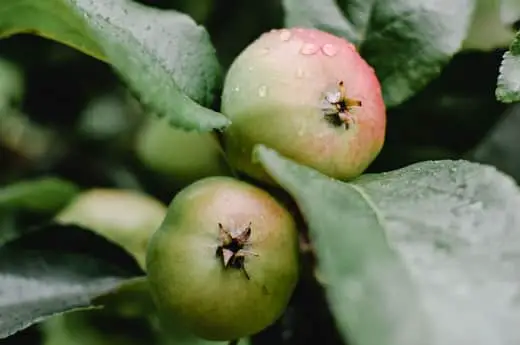
Similar to apple bonsai, their little brothers aka crab apple bonsai are also perfect for beginners.
What’s even better is because crabapple bonsai trees produce smaller fruit, these are a lot more common than finding people who own traditional apple bonsai.
Crabapple bonsai requirements | Detail |
Water | Once per day in summer, twice per week in winter. Touch to see if the topsoil is dry before watering. Do not water when topsoil is wet. |
Sunlight | 6 to 8 hours of direct sunlight in the summer months. A little shade in the brightest months of summer |
Fertilizer | Once per month in the spring and summer. No fertilizing in the fall and winter |
Soil mix | Akadama and volcanic rock mix |
Location | Outdoor only, bright spots in the garden. |
Time to grow into mature bonsai | 10 years |
Advantages of crabapple bonsai
- Can be grown in any climate – Similar to apple trees, these bonsai can be grown in most climates regardless of how warm or cold they are.
- Easier to prune – Pruning an apple tree bonsai can be difficult due to the size of the apple. As crabapples are smaller, they can be much easier to trim.
- Any soil – Although volcanic ash and akadama work best, they are very versatile allowing you to grow in any type of soil.
Disadvantages of crabapple bonsai
- Shorter lifespan – These trees, even when transformed into bonsai, tend to have a shorter life expectancy of around 40 years.
- Susceptibility to diseases – These trees are very susceptible to common mold and fungal diseases that bonsai trees get.
When to pick the crab apples?
Crab apples from crabapple bonsai will need to be picked in the fall, between October, and November. Crab apple bonsai needs to be planted or repotted as early in the spring as possible.
How beginner-friendly is crab apple tree bonsai
Crab apple bonsai is also a very easy and beginner-friendly bonsai tree to grow. It might even be a little easier than apple trees bonsai. Crabapple bonsai then get a 9/10.
Orange tree bonsai
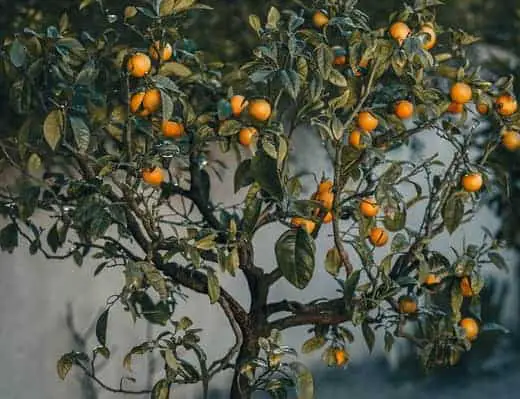
Orange trees can make a bonsai collection pop with the bright orange color of the citrus fruit.
Pair on top of this that they produce incredibly sweet fruit it’s easy to see why these are a popular bonsai choice.
That being said, they cannot be grown in all climates and can be a little fidgety as a beginner.
Orange Bonsai Requirement | Detail |
Water | Once per day in summer, twice per week in winter. Touch to see if the topsoil is dry before watering. Do not water when topsoil is wet. |
Sunlight | 5-6 hours of direct sunlight in the summer months. A little shade in the brightest months of summer |
Fertilizer | Once per month in the spring and summer. No fertilizing in the fall and winter |
Soil mix | Akadama and volcanic rock mix |
Location | Outdoor only, bright spots in the garden. |
Time to grow into mature bonsai | 12 years - although oranges will start to grow in 3 years. |
Advantages of orange tree bonsai
- Easier to prune – Orange bonsai trees are relatively easy to prune the wood is not tough making it easy to bend and develop the trunk.
- Any soil – Although volcanic ash and akadama work best, they are very versatile allowing you to grow in any type of soil.
- Quick fruit – Despite these trees taking a while to hit maturity, they can produce fruit relatively fast, in about 2 to 3 years after being planted.
Disadvantages of orange bonsai
- High temperatures – Orange bonsai need to be kept in warm conditions daily with a minimum temperature of 18 degrees to produce sweet fruit and a lot of sunlight or artificial light. As such, they are not viable in cold climates like the Uk without a greenhouse.
- Citrus longhorn beetle – Specific to citrus trees, these beetles can cause significant damage in citrus bonsai.
- Cannot be grown in the same pot as other citrus plants – if you are growing oranges in an old pot that used to keep other citrus plants, or in a shared pot with different bonsai, then orange bonsai may not fruit.
When to pick the oranges?
Oranges from orange bonsai will need to be picked in December to ensure the ripest sweetest oranges. Wait until their full color appears before picking from your orange bonsai
How beginner-friendly is orange tree bonsai
While orange bonsai can be a little more complicated than some of the other species, if you live in a warm climate it can work very well. 6/10
Cherry bonsai
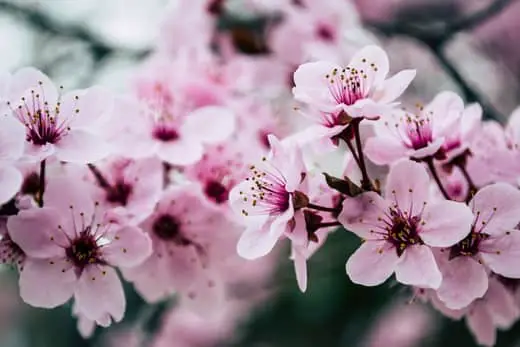
Think of bonsai and cherry blossom bonsai is probably one of the first things you can think of. As such, cherry bonsai trees are a fantastic beginner option if you would like a fruiting tree.
Cherry Bonsai Requirements | Detail |
Water | Once per day in summer, twice per week in winter. Touch to see if the topsoil is dry before watering. Do not water when topsoil is wet. |
Sunlight | 8 hours of direct sunlight in the warm summer months |
Fertilizer | Once per month in the spring and summer. No fertilizing in the fall and winter |
Soil mix | Akadama and volcanic rock mix |
Location | Outdoor and indoors if kept in a warm home. |
Time to grow into mature bonsai | 2-3 years to bloom, 8 years for a mature-sized tree. |
Advantages of cherry bonsai
- Used for bonsai – unlike some of the other fruit species on this list, cherry bonsai and cherry blossom bonsai in particular are encouraged for use in bonsai.
- Any soil – Although volcanic ash and akadama work best, they are very versatile allowing you to grow in any type of soil.
- Beautiful – Cherry bonsai trees, especially cherry blossom, because of their pink petals are often viewed as some of the most aesthetically pleasing trees.
Disadvantages of cherry bonsai
- Better outdoors – Whilst these can be kept indoors, their sunlight requirements mean that they need to be kept outdoors for best results.
- Toxic pips – If the cherries fall off the tree, the pips can be toxic to many household pets.
- Fungal infections – These bonsai species tend to be more susceptible to fungal infections than other trees species.
When to pick the cherries?
Cherries from cherry bonsai will need to be picked in early summer for best results. Pick from the stalk, not the fruit, and pick during dry weather.
How beginner-friendly is cherry bonsai
Cherry bonsai is also a solid choice for a beginner fruiting bonsai tree. I would give these an 8/10
Blueberry bonsai
While not as popular as cherry bonsai, blueberry bonsai is an often overlooked bonsai tree species that is fairly easy for beginners to grow.
Bluberry Bonsai Requirement | Detail |
Water | Once per day in summer, twice per week in winter. Touch to see if the topsoil is dry before watering. Do not water when topsoil is wet. |
Sunlight | 6 hours of direct sunlight in the warm summer months. Keep in the shade at the hottest part of the day. |
Fertilizer | Once per month in the spring and summer. No fertilizing in the fall and winter |
Soil mix | Akadama and volcanic rock mix - organic soil such as cactus soil or peat soil mix also works well. |
Location | Outdoor only |
Time to grow into mature bonsai | 3-4 years for fruit, 8 years for a mature-sized tree. |
Advantages of blueberry bonsai
- Not used for bonsai – As these trees are not used all too often for bonsai, this means that they will be rarer to come by, making your collection more unique
- Any soil – Although volcanic ash and akadama work best, they are very versatile allowing you to grow in any type of soil.
- Beautiful – Blueberry bonsai trees have a distinct look. The navy/purple blueberry makes the tree stand out in bonsai collections.
Disadvantages of blueberry bonsai
- Better outdoors -The sunlight requirements mean that they need to be kept outdoors for best results.
- Pests – As these species of fruit are not very strong, they are easy to penetrate by pests making them more susceptible to bug infestation.
- Fungal infections – These bonsai species tend to be more susceptible to fungal infections than other trees species.
When to pick the berries?
Blueberries from blueberry bonsai can be picked year-round, so long as the berries are dark blue. Blueberries should not need force to pull off and instead should come off the tree easily.
How beginner-friendly is cherry bonsai
Apart from some of the pest conditions associated with blueberry, this can be a fairly straightforward tree to grow – 7/10
Blackcurrant Bonsai
While blackcurrant is more often found in bushes (or in popular fruit drinks for that matter) similar to berries these can also work as very good bonsai fruit trees for beginners.
Blackcurrant Bonsai Requirements | Detail |
Water | Once per day in summer, twice per week in winter. Touch to see if the topsoil is dry before watering. Do not water when topsoil is wet. |
Sunlight | 6 hours of direct sunlight in the warm summer months. Keep in the shade at the hottest part of the day. |
Fertilizer | Once per month in the spring and summer. No fertilizing in the fall and winter |
Soil mix | Akadama and volcanic rock mix |
Location | Outdoor only |
Time to grow into mature bonsai | 1-2 years for fruit, 8 years for a mature-sized tree. |
Advantages of blackcurrant bonsai
- Fast-growing fruit – Whereas other first bonsai species can take a while for their fruit to grow, blackcurrant bonsai trees will usually start to bear fruit in the first 2 years.
- Not used for bonsai – As these trees are not used all too often for bonsai, this means that they will be rarer to come by, making your collection more unique or a fantastic gift for a bonsai enthusiast.
- Beautiful – The purple blackcurrant berries make this species much better looking and add a significant pop to any bonsai collection.
Disadvantages of blackcurrant bonsai
- Better outdoors -The sunlight requirements mean that they need to be kept outdoors for best results.
- Pests – as these species of fruit are not very strong, they are easy to penetrate by pests making them more susceptible to bug infestation.
- Fungal infections – These bonsai species tend to be more susceptible to fungal infections than other trees species.
When to pick blackcurrants?
Blackcurrants should be picked from blackcurrant bonsai in July/August. Aim for a dark blue/purple color. Blackcurrants should also be easy to pick and force
How beginner-friendly is blackcurrant bonsai
Similar to blueberries, pest conditions aside, blackcurrant bonsai is a solid beginner-friendly fruiting bonsai – 7/10
Lime bonsai
Citrus bonsai such as lime are incredibly popular. Unlike other citrus varieties such as orange, lime bonsai can traditionally be grown in most climates making them beginner-friendly.
Lime Bonsai Requirements | Detail |
Water | Once per day in summer, twice per week in winter. Touch to see if the topsoil is dry before watering. Do not water when topsoil is wet. Avoid lime or lemon water. |
Sunlight | 6 to 8 hours of direct sunlight in the summer months. Keep in the shade at the hottest part of the day. |
Fertilizer | Once per month in the spring and summer. No fertilizing in the fall and winter |
Soil mix | Akadama and volcanic rock mix. |
Location | Outdoor only |
Time to grow into mature bonsai | 1-2 years for fruit, 8 years for a mature-sized tree. |
Advantages of lime bonsai
- Fast-growing – Lime bonsai is very fast-growing adding on average around 13 inches per year – This means that if growing from scratch you can get a well-developed tree in a short period.
- Wide breadth of information – Lime bonsai are a common fruiting bonsai and so the breadth of information available to grow these trees as a beginner is huge.
- Most climates – While they need to be protected in fall/winter by being kept indoors – these trees can thrive better than other citrus varieties in most climates.
Disadvantages of lime bonsai
- Need to be kept indoors in winter – Citrus bonsai such as lime thrive in the heat and so need to be placed indoors in the fall and winter to prevent them from dying.
- Pests – Expect a lot of pests with the bright color of lime attracting a lot of unwanted pests.
- Long time for fruit – Lime bonsai can take up to 6 years before they bear any fruit so patience will be required to grow these.
When to pick lime?
Lime should be picked from lime bonsai in May to June and then again in November and December. There are typically two harvesting times for lime trees.
How beginner-friendly is Lime bonsai
As the breadth of knowledge for lime, bonsai is huge, and as they are fast-growing these are an ideal beginner-friendly fruiting bonsai – 9/10
Lemon bonsai
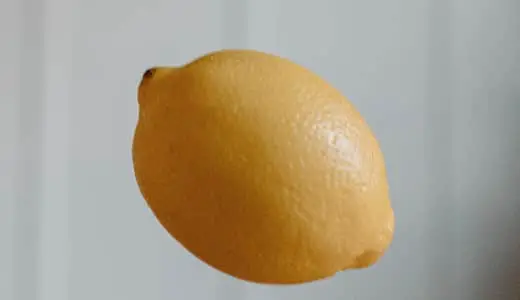
Just like their close relatives lime bonsai, these too are also incredibly popular for bonsai usage.
Lemon too can be grown in most environments.
Lemon Bonsai Requirements | Detail |
Water | Once per day in summer, twice per week in winter. Touch to see if the topsoil is dry before watering. Do not water when topsoil is wet. Avoid lime or lemon water. |
Sunlight | 6 to 8 hours of direct sunlight in the summer months. Keep in the shade at the hottest part of the day. |
Fertilizer | Once per month in the spring and summer. No fertilizing in the fall and winter |
Soil mix | Akadama and volcanic rock mix. |
Location | Outdoor only |
Time to grow into mature bonsai | 1-2 years for fruit, 8 years for a mature-sized tree. |
Advantages of lemon bonsai
- Fast-growing – Lemon bonsai is very fast-growing adding on average around 13 inches per year – this means that if growing from scratch you can get a well-developed tree in a short period.
- Wide breadth of information – Lemon bonsai are a common fruiting bonsai and so the breadth of information available to grow these trees as a beginner is huge.
- Most climates – While they need to be protected in fall/winter by being kept indoors – these trees can thrive better than other citrus varieties in most climates.
Disadvantages of lemon bonsai
- Need to be lept indoors in winter – Citrus bonsai such as lemon thrive in the heat and so need to be placed indoors in the fall and winter to prevent them from dying.
- Pests – Expect a lot of pests with the bright color of lemon attracting a lot of unwanted pests.
- Long time for fruit – These bonsai can take up to 6 years before they bear any fruit so patience will be required to grow these.
When to pick lemon?
Lemon bonsai produces fruit year-round and so can be picked year-round. Lemons should only be picked when bright yellow and two to 3 inches in size.
How beginner-friendly is Lemon bonsai
As the breadth of knowledge for lemon, bonsai is huge, and as they are fast-growing these are an ideal beginner-friendly fruiting bonsai – 9/10
Pomegranate bonsai
A fruit species that not too many in Europe and the west eat are pomegranate. This tree produces bright sweet red fruit encased in a solid round cocoon-like structure. Despite their rarity in being eaten, they are very common in bonsai use.
Pomegranate Bonsai Requirement | Detail |
Water | Once per day in summer, twice per week in winter. Touch to see if the topsoil is dry before watering. Do not water when topsoil is wet. Avoid lime or lemon water. |
Sunlight | 6 to 8 hours of direct sunlight in the summer months. Keep in the shade at the hottest part of the day. |
Fertilizer | Once per month in the spring and summer. No fertilizing in the fall and winter |
Soil mix | Akadama and volcanic rock mix. |
Location | Outdoor in summer, indoors in fall and winter |
Time to grow into mature bonsai | 5 years years years for fruit, 8 years for a mature sized tree. |
Advantages of pomegranate bonsai
- Fast-growing – pomegranate trees are fast-growing and can grow upwards of two feet a year. This means that if growing from scratch you can get a well-developed tree in a short period.
- Wide breadth of information – pomegranate bonsai are a common fruiting bonsai and so the breadth of information available to grow these trees as a beginner is huge.
- Bonsai trunk – pomegranate bonsai usually have wide bendy trunks, making them ideal for bonsai with trunks already naturally developed in most cases.
Disadvantages of pomegranate bonsai
- Warm climates – As these bonsai grow in warmer climates such as southeast Asia, they prefer hotter conditions, Avoid keeping them outdoors in winter
- Fruit yield – Pomegranate fruit is very inconsistent with their quality even in each pomegranate pod – you might find some of them are sweet whilst others are not.
When to pick pomegranate?
Pomegranate fruit should be picked from pomegranate bonsai when the skin is soft and can be easily peeled. Aim to look for a bright red color.
How beginner-friendly is pomegranate bonsai
As the breadth of knowledge for bonsai is huge, and as they are fast-growing these are ideal beginner-friendly fruiting bonsai. That being said the temperature conditions may prove tricky for some – 8/10
Fig bonsai
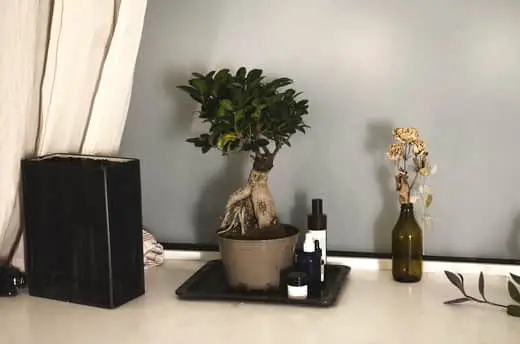
When it comes to fruiting bonsai, another beginner-friendly fruiting tree I would recommend is fig bonsai, more commonly known as ficus bonsai. Fig bonsai have been growing for hundreds of years as bonsai trees and are one of the more common fruiting trees.
Ficus Bonsai (fig) Requirement | Detail |
Water | Once per day in summer, twice per week in winter. Touch to see if the topsoil is dry before watering. Do not water when topsoil is wet. Avoid lime or lemon water. |
Sunlight | 4 to 6 hours of direct sunlight in the summer months. Keep in the shade at the hottest part of the day. |
Fertilizer | Once per month in the spring and summer. No fertilizing in the fall and winter |
Soil mix | Akadama and volcanic rock mix. |
Location | Indoor and outdoor |
Time to grow into mature bonsai | 5 years years years for fruit, 8 years for a mature sized tree. |
Advantages of fig bonsai
- Available everywhere – As these bonsai are so commonplace in bonsai usage, you should have no difficulty in finding them
- Inexpensive – As these trees are not junipers but common trees found globally this means they are relatively inexpensive
- Propagate easily – if growing from scratch fig bonsai can be very easy to grow – making them ideal for beginners.
Disadvantages of fig bonsai
- Attract pests – Like all fruiting bonsai, expect a lot of pests when it comes to these trees
When to pick figs?
Figs should be picked from fig tree bonsai after about 70 to 100 days of small rice-like figs starting to develop on the leaves of the tree. Picking these too early will result in bitter-tasting figs.
How beginner-friendly is fig bonsai
Fig bonsai aka ficus bonsai as it is better knowns is easily the best bonsai fruit trees for beginners- – 10/10
Olive bonsai
Like fig bonsai, olive bonsai is also a very common tree to use when creating a bonsai tree, easily making them the best bonsai fruit tree for beginners.
The trees are so common in fact, that I’ve gone into more detail on them in my specific post here.
Olive Bonsai Care | Explained |
Water | Check once per day if the soil is dry to the touch. If so, the olive tree needs watering. Non-bonsai olive trees require watering only once per week, but bonsai trees typically will need more water so once per day should be ideal. Only water once per week during the winter in cold temperatures. |
Sun | 4 to 8 hours of direct sunlight in the summer |
Temp | 0-95 degrees Fahrenheit ( -12 to 35 degrees celsius) |
Local | Both indoors and outdoors in a spot that gets a lot of sunlight |
Food | Fertilize once per month during the summer months. No fertilizing is required in winter. |
Growth | Slow growing - 2 to 4 inches per year. |
Advanatges of olive tree bonsai
- Water requirements – Whilst these trees will still need to be watered, they often do not need to be watered as much as other bonsai species. Watering once per day should work.
- Clean the air – Should you keep your olive bonsai indoors, it can help with purifying the air.
- New roots – Olive trees bonsai can easily create new roots, making it much easiest to create deadwood such as nebari.
Disadvantages of olive tree bonsai
Like all tree species, olive trees also have many significant disadvantages to contend with.
These include
- Slow growing – Olive tree bonsai typically only grow a few inches every year meaning they can take a while to shape
- Tough wood – Olive tree bonsai has tough wood meaning stronger copper wire has to be used when wiring – this is more likely to lead to breakages in the mark
- Harsh winters – Olive tree bonsai need to be kept indoors during cold winters or else they will die
When to pick Olives?
Olives should be picked in the early fall or, more specifically late September from olive bonsai.
How beginner-friendly is olive bonsai
Olive bonsai are very beginner-friendly, with olive tree bonsai being amongst the most popular fruiting species of bonsai used. They can be a little tough to work with due to their hardwood but a good choice nonetheless making the list of one of the best bonsai fruit trees for beginners– 8/10
Callicarpa Japonica
So this bonsai species isn’t all too common and is usually reserved for experts to add to their collections. That being said, the tree is very easy to work with making it ideal for beginners.
Callicarpa Japonica Requirements | Detail |
Water | Once per day in summer, twice per week in winter. Touch to see if the topsoil is dry before watering. Do not water when topsoil is wet. Avoid lime or lemon water. |
Sunlight | 4 to 6 hours of direct sunlight in the summer months. Keep in the shade at the hottest part of the day. |
Fertilizer | Once per month in the spring and summer. No fertilizing in the fall and winter |
Soil mix | Akadama and volcanic rock mix. |
Location | Outdoor in summer - must be protected indoors in winter. |
Time to grow into mature bonsai | 5 years for fruit, 8 years for a mature-sized tree. |
Advantages of Callicarpa Japonica
- Natural insect repellent – Beauty Berrys the bonsai will produce can act as a natural insect repellent
- Not widely available – meaning that it will make your bonsai collection unique
- The berries are edible – unlike other berries, the berries from this tree can also be eaten.
Disadvantages of Callicarpa Japonica
- Birds – Due to the bright pink, pearl-like berries, these can often be eaten by birds, in the fall
- Lack of information – As these fruiting bonsai are rarer in bonsai circles it can sometimes be challenging to find adequate information on wiring, pruning, and caring for this tree.
When to pick beauty berries?
Beauty berries should be picked in the late fall to the early winter. This is when they will be at their most ripe and brightest in color.
How beginner-friendly is Callicarpa Japonica
Despite being hard to find and having to deal with birds attacking the tree, it does make for a fantastic option for beginners- 7/10
Japanese winterberry bonsai
Japanese winterberry is one of those species of tree that again, not too many people have but can add to the look of a bonsai collection. It has an authentically Japanese look and adds a pop of color in bonsai collections.
Now whilst this might sound like a tree for a bonsai keeper who has kept trees for decades, the truth is despite its fancy name, this tree is relatively easy to keep which is why I’ve included it on this list of best bonsai fruit trees for beginners.
Japanese Winterberry Requirements | Detail |
Water | Once per day in summer, twice per week in winter. Touch to see if the topsoil is dry before watering. Do not water when topsoil is wet. Avoid lime or lemon water. |
Sunlight | 4 to 6 hours of direct sunlight in the summer months. Keep in the shade at the hottest part of the day. This plant should be kept outdoors year-round. |
Fertilizer | Once per month in the spring and summer. No fertilizing in the fall and winter |
Soil mix | Akadama and volcanic rock mix. |
Location | Outdoor in summer - must be protected indoors in winter. |
Time to grow into mature bonsai | 2-3 years for fruit, 6 years for a mature-sized tree. |
Advantages of Japanese Winterberry
- Not widely available – Meaning that it will make your bonsai collection unique
- Outdoor only – Unlike other bonsai trees that you have to bring in during the winter, Japanese winterberry is comfortable being left outdoors year-round.
Disadvantages of Japanese Winterberry
- Birds – Due to the bright pink colored berries, these are often eaten by birds during the fall
- Toxic berries – Japanese winterberries are not safe for consumption and should only be used for decorative purposes.
When to pick Japanese winterberry bonsai?
Japanese winterberry bonsai berries will ripen in mid-fall. These berries however should not be picked as they can be toxic and should be left on for display purposes only.
How beginner-friendly is Japanese winterberry bonsai?
Now while these bonsai are challenging in the sense of being kept outdoors year-round, and not producing fruit you can eat, they are still simple enough to manage if cared for correctly. A definate recomnedation as one of the best bonsai fruit trees for beginners- 7/10
What is the best fruit tree bonsai?
Fig trees bonsai, better known as ficus bonsai is the best fruiting bonsai tree for beginners. Not only is the tree commonly used in bonsai already, but it is also very resilient, making it hard to kill if overwatered, or if not given enough sunlight.
What fruit should you avoid growing as a bonsai tree?
Mango bonsai trees should be avoided by most beginners. This is because mango bonsai trees only typically thrive in a very warm climate such as southeast Asia and can be difficult to grow in colder milder climates. Mango bonsai are also preyed upon by insects.
Mango bonsai trees, papaya, and other large fruits should not be found on any best bonsai fruit tree for beginners list.
How long will it take for a bonsai tree to fruit?
Bonsai trees will typically fruit before they are matured. For example, you can expect lemons, limes, and other citrus bonsai to fruit at the six-year mark. These species will typically reach maturity at the 8 to 10-year mark.
What is the easiest bonsai fruit tree to take care of?
I wanted to get to the bottom of what the best bonsai trees for beginners was so I asked 10 plant paladin readers to do a quick survey for me to find out what exactly the best bonsai fruit tree for beginners was:
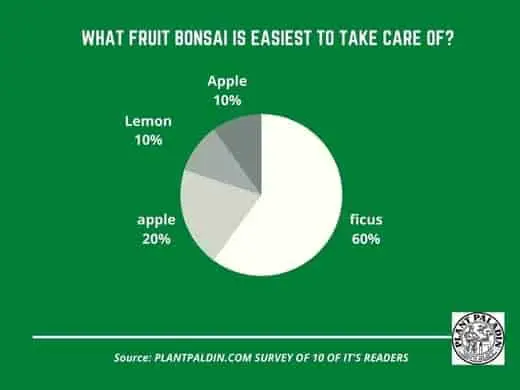
My top picks for the gear you will need!
So like I mentioned earlier, over the past three years of running PlantPaladin, hundreds of people have asked me for my recommendations on the best bonsai gear on the market.
Having spent thousands of dollars on bonsai items these past few years and tested at least 100 bonsai-specific products, I’ve listed my favorite products below – All of which I highly recommend and think you can get great value.
They can purchase directly by clicking the link to take them to Amazon.
Bonsai Tool Set: One of the significant challenges I’ve had is finding a toolset that was not only durable but didn’t break the bank. SOLIGT has recently developed a fantastic bonsai tool set that covers all the tools you need to trim, prune, and repot your trees. – You can grab it here.
Complete Bonsai Set: Many of you will want to grow your bonsai trees entirely from scratch, but finding the varicose seeds, pots, and other items in one place can be challenging. Leaves and Sole then have created a complete bonsai set that I’ve personally used that ticks all the boxes. You can grab it here.
Bonsai wire: The number of times I’ve run out of wire for my bonsai or purchased cheap bonsai wire that doesn’t do the job is embarrassing for me to admit. After a lot of trial and error, I found that using Hotop’s aluminum bonsai wire is one of the best options on the market. This can easily be used for both indoor and outdoor bonsai. You can grab it here.
